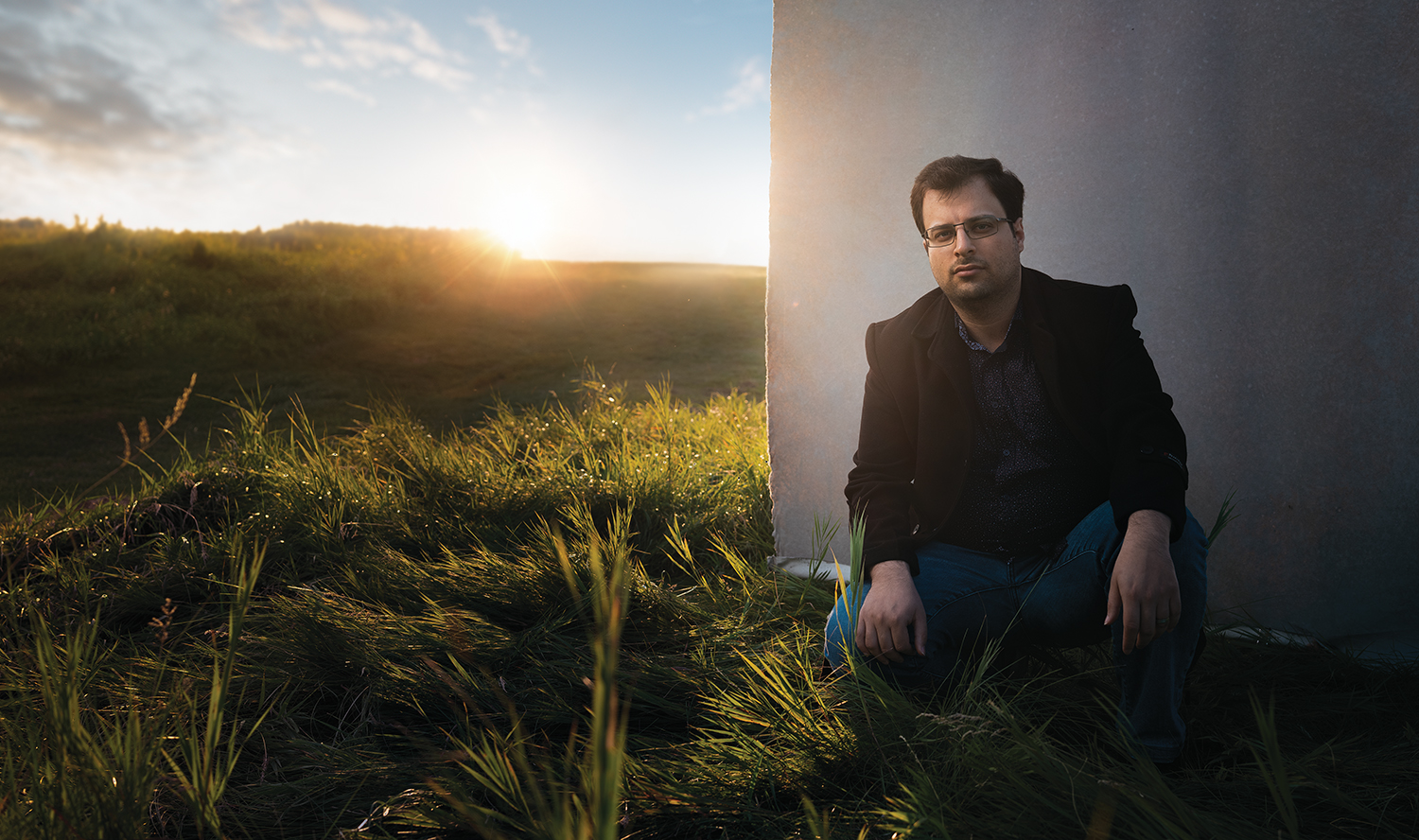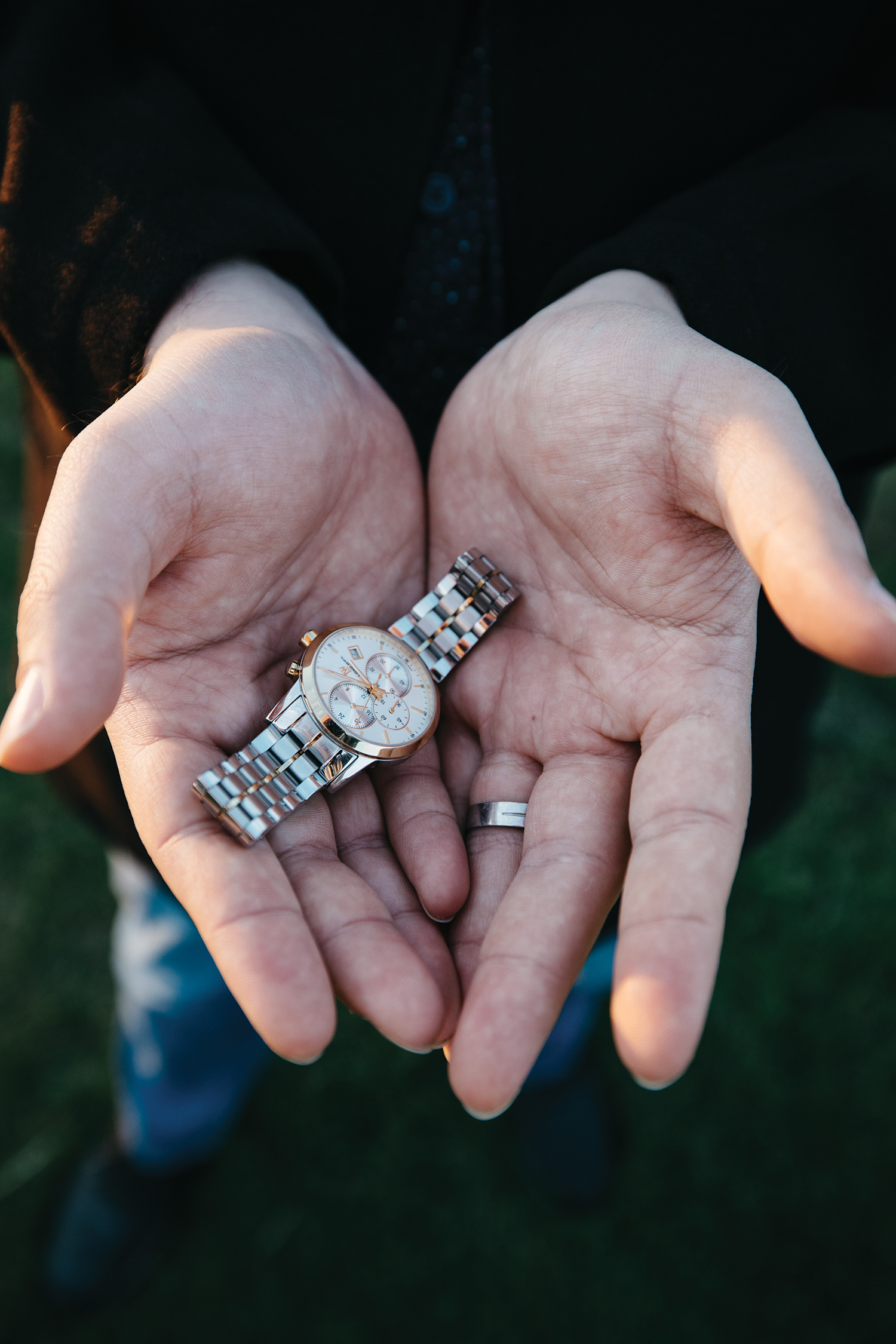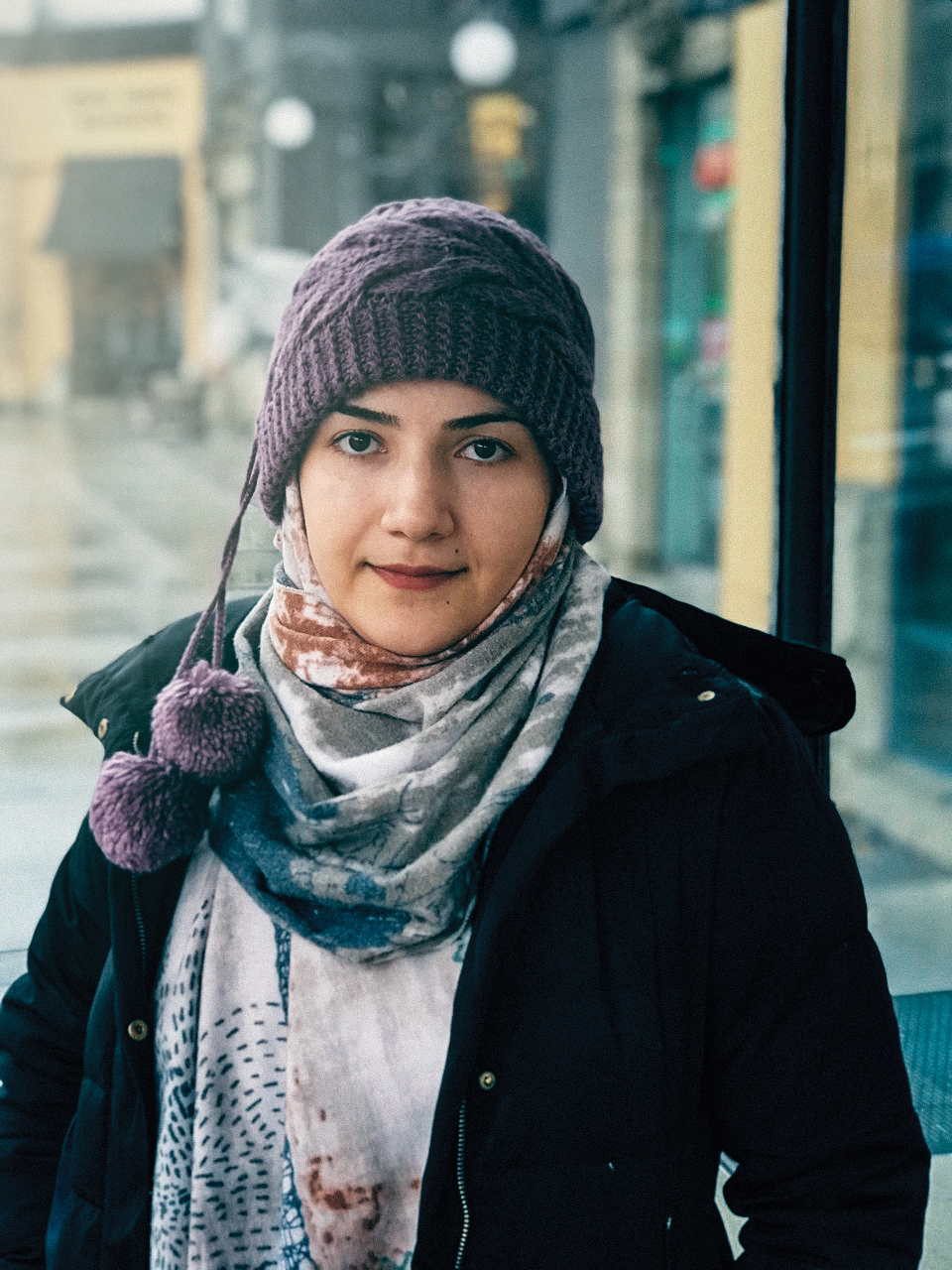Javad Soleimani Meimandi places his backpack on a picnic table and delicately removes the contents. A leather-bound certificate folder bears the same University crest as his spruce-green hoodie. He looks like he’s just left class, but he hasn’t touched his PhD in six months. Not since that night in the U of A’s Fishbowl, when a breaking news alert stole his attention and engulfed his life.
Sitting six feet away from me in Kitchener Park, Javad recalls it as if describing a movie he just watched.
His first thought upon reading the headline was, no way it could be her.
His wife, Elnaz Nabiyi, had just texted to confirm boarding the plane from Tehran to Kyiv, the first of three flights until she was back in his arms. Those nearly three weeks apart were the longest they’d endured as a couple. He’d booked a haircut for their reunion. He planned to clean the apartment. In 23 hours, he’d greet her at the airport.
Then he read the flight number: PS752. Those five characters exploded into the universe and unleashed a black hole that turned everything dark and matter-less.
Even after another singular crisis erupted into his universe, and yours, the pandemic was dwarfed by his grief. “The only thing I want in life is justice for those innocent lives on board,” he says, holding an enlarged portrait of Elnaz. “Everything else is meaningless.”
Justice, to him, is an international court prosecuting the entire chain of command whose actions led to killing all 176 people (and one unborn child) on board; who tried to cover it up; who sent agents to victims’ funerals to promote the state’s narrative; who coerced defiant families into silence and exile. He’s under no illusion that it will be easy. In a twisted way, Javad feels lucky for a Sisyphean battle. It’s given his life meaning again. “Without this, I’d be dead,” he says with uncomfortable laughter too feeble to soften his words and, amid children giggling around us, only stresses their bleakness.
Javad suggested the playground near his apartment to observe social distancing. It had special meaning, too, as the location of the last video he captured of Elnaz outside in Edmonton. Before he plays it for me, I’m not sure whether to tell him I’ve already watched it.
To endure the impossible loneliness of being a widowed immigrant self-isolating throughout an Edmonton winter, Javad posted videos, photos, poems and vignettes of memories to his social media on a near daily basis. So I’m familiar with the objects he brought along. I know her portrait and posthumous honorary PhD sit on a console beside her hairbrush, and that Elnaz’s hairbrush is the only personal possession he’ll allow himself to use. I know he’s preserved her clothes with protective material. I know jokes they shared and parenting values they’ll never put into practice. And though I don’t know this for sure, I suspect a reason he’s made this so public is to counter Iran’s attempt to make its citizens forget.
Javad plays the video of Elnaz and translates her words. In it, she sits at the top of a slide, wearing a light headscarf and puffy vest. “Since you are taking a video,” she says, a little embarrassed, “let me say hi to all Iranian people. Forgive me if I annoyed you. Goodbye.”
A smile creeps over Javad’s face. “It’s stupid, I know, but I have a little bit of hope that she’s going to come back home. Somehow, I’m stuck on January 8th.”
Javad and Elnaz’s love story began the way it ended; in a school library. During his first semester of his MBA at Tehran’s Sharif University of Technology, Javad spied her delicate hands turning the pages of a book with impressive speed. Elnaz, he’d soon learn, possessed a mind like no other. But, during that moment in 2014, all Javad knew were her hands. He crept around the library to steal a look at their “owner,” and, over the next year-plus, worked for permission to put a ring on those hands.
Born in 1989 to a teacher and a researcher, Elnaz wasted no time living up to her name, “Pride of the People.” Elnaz kept a quiet confidence, even as she was recruited to a school for gifted children, and won awards for the school’s math and physics teams. You knew you were in trouble, though, whenever she’d smile coyly seconds before challenging your opinion, and proving you wrong. For every two hours she studied, Javad put in 10 for the same results. That she still left everything till the last minute amused and frustrated him.
Their differences went beyond intellect. Elnaz lived in the moment, Javad planned everything. He even picked out baby names: Raha (“Free”) for a girl, Omid (“Hope”) for a boy. Elnaz was content leaving the possibility of children to God. She was inquisitive, always in search of truth and, with the same effort she applied to school, she studied her faith closely. But Elnaz resented Iran’s theocracy; detested compulsory hijabs and the ways religion was exploited to divide and distract.
As an adult, Elnaz was in a better position to see the government’s ambivalence for human capital. She grew more cynical when, after completing their MBAs, the couple collaborated on a job with the Ministry of Health to devise an investment package for a private-public partnership to build new hospitals. Elnaz thought her husband was foolish for exhausting over it. “What are you doing, Javad?” she asked. “Really? What are you doing killing yourself for these people? They don’t respect your knowledge or skills. You’re working so hard to actually design a feasibility study, but, at the end of the day, they’ll decide whatever they like.”
After the hospital development contract was awarded to a corporate shadow firm of the Defence Ministry, Javad conceded that his efforts were being squandered in Iran. Fearing they’d gradually become corrupted lackeys themselves, Elnaz proposed they apply for international PhD programs. “If I stay any longer, I think I’ll turn into Heisenberg,” she joked, referencing the alter ego of Walter White, the chemistry teacher-turned-drug lord in Breaking Bad. “No more Walter White. I’m applying today.”
There are many reasons why professor Ivor Cribben remembers his first impression of Elnaz Nabiyi so well. Her refreshing directness. The emphasis she placed in her application’s statement of purpose on increased female representation in the field of accounting and business analytics. But, most of all, it was her determination to complete a doctorate at the University of Alberta School of Business in four years, instead of the usual five or six. Usually, students want to ease into their research by getting a handle on their coursework first. Elnaz wished to start researching immediately. “She’d made up her mind,” says Cribben.
He accepted Elnaz as his first PhD student in fall 2018 and, together, researched how to apply artificial intelligence to emergency medical services. Using machine learning techniques and Alberta Health Services’ time-stamped data on emergency calls, they hoped to forecast emergency volume calls, which would lead to better forecasting for bed allocation, ventilators, staffing and possibly work all the way down the chain to the hospital cafeteria. She sailed through her coursework, seldom speaking unless to ask incisive questions. “She’d look me straight between the eyes, tell me the problem, and say, ‘Let’s solve it together.’” By the end of her first year, Elnaz ranked first amongst her PhD cohorts.
Cribben believed he’d found someone with limitless potential. Elnaz had all the qualities of a world-class researcher. If her career continued on the same trajectory, she’d easily earn a position at a premier academic institution. The only thing that could hold her back, maybe, was homesickness.
Although she and Javad were enrolled in the same PhD program and most classes together, her husband and best friend could not replace the comfort of family. Neither could the freedom that Elnaz felt in Canada — the access to endless literature, the new perspectives gleaned from meeting so many different people and the tendency of Canadians to mind their own business. At times, her world had never felt bigger. Then a text or Instagram comment from family would remind Elnaz of how much they missed her, how much she missed them — and her world felt suddenly tiny.
Spending a month of summer 2019 in Iran only made her more homesick. The couple had barely returned to Edmonton when Elnaz started planning her next visit over Christmas holidays. Javad wanted to join her but his PhD supervisor advised against it, after Javad transferred to marketing from operations management. Cribben, on the other hand, didn’t see it as an impediment to their research. “Being an immigrant myself, I said, ‘It’s important you keep that relationship with your home and your parents,” he recalls. “I wish I hadn’t told her to go home.”
Between her two trips, in summer and then winter, everything changed for Iranians.
In November 2019, a surprise fuel-price hike triggered demonstrations by college-educated youth, whose only remaining jobs were driving delivery vans and taxis. The government initially tried to deflect toward the United States’ efforts to reopen the 2015 nuclear agreement with the toughest sanctions ever imposed on Iranian exports. But five straight years of growing unemployment and staggering inflation aren’t easily diverted. As protests began to look more like an up- rising, the Iranian regime used many means to crush them, including violence.
Javad and Elnaz had never seen such brutality in their lifetimes. Estimates from Ayatollah Khamenei’s own inner circle, which were provided anonymously to Reuters, calculated 1,500 civilians dead. “She was really angry and upset,” says Javad. Elnaz cried daily watching disturbing footage captured on social media, but, even as clashes flared up in the weeks before departure, she never considered a refund on her plane tickets. She’d even booked through Ukraine International Airlines, despite shorter journeys available, to prolong her time with family by two days.
Elnaz’s trip proved to be emotional but gratifying and even productive for her research. She’d booked a return flight with Ukraine International Airlines. But, on January 3, 2020, five days before her return, an American drone strike killed General Qasem Soleimani, who was considered a national hero by some who supported the Iranian government, and even some who didn’t.
Iranian forces retaliated just after midnight on January 8.
The sun was still up in Edmonton, where Javad, sitting in the Fishbowl, caught headlines of Iran’s missile strikes on U.S. army bases in Iraq. He texted the news to Elnaz. En route to the airport she had not yet heard the news. Javad asked Elnaz to check on her flight details again. Surely it had been cancelled or delayed. It hadn’t.
They texted for the next two hours.
Darling, it’s become very dangerous.
Get out immediately.
I passed the gate
Let me know before you take off
I boarded the plane
Great.
Hurry, take off already cause things are going south
Yeah
Did it take off?
Not yet
Javad was relieved when he stopped getting texts around 5:15 a.m. Tehran time, assuming her flight had taken off right on schedule. Sitting with his friend in the university library, Javad exhaled, then returned to his studies.
Two hours later, he was stumbling through the streets, wailing her name. Elnaz, pride of the people.
One of the first steps of probing an aircraft disaster is a read-out of the flight recorders. Iran withheld PS752’s black boxes from international investigators until July. That’s just one example of how it stalled and obfuscated the inquiry since the moment of the crash, which the government immediately blamed on technical problems, in spite of contradicting video evidence from witnesses. It took U.S. satellite imagery and international pressure to even admit some human error. Reports published by the Iranian Aircraft Accident Investigation Bureau, which continued to fault technology, have largely been dismissed, and attempts to leverage the tragedy to reopen ties with Canada, suspended since 2012, have further undermined trust in the “official” story.
Nothing though has proven Iran’s indifference for truth more than its harassment of grieving families demanding more accountability and transparency.
After arriving in Zanjan to bury Elnaz, Javad was shocked to see uninvited officials from the religious and armed forced departments “hijack” her private funeral service. To further a narrative that the passengers had died for the Islamic Republic, they enforced a version of a state funeral for the “shaheeda” (female martyr) and taped a poster on her casket that read “Congratulations on your martyrdom.” Javad says that when he questioned and criticized authorities present, he was summoned the next day into the local intelligence services office to explain his supposedly indignant behaviour.
Outspoken relatives of victims living in Iran were subjected to systematic surveillance, harassment and intimidation, while some in Canada report being trolled by suspicious accounts calling them traitors. Last March, Javad refused to delete an Instagram post critical of the government at the behest of a caller who claimed to be a high-ranking official. The man then tried to apply pressure by harassing his and Elnaz’s parents with phone calls. “I knew that the Iranian regime is brutal, but, honestly, I didn’t expect this,” says Javad, who recorded the call for media.
The man was later identified by CBC as Iran’s lead investigator for the crash, and may have accidentally leaked the most damning evidence of government negligence yet. During the 90-minute conversation, the investigator hinted that the airspace remained open to conceal an imminent attack on U.S. bases, and that closing it would have cost the government revenue from overflight fees.
Here’s what we do know: After avenging the major general’s death, Iran’s air defence unit was on high alert for incoming cruise missiles. The airspace should have been closed. Whether civilian authorities refused the orders, or whether they were ordered at all, isn’t public knowledge. But we know that other commercial jets took off from Imam Khomeini International in the five hours between the firing of 15 missiles at U.S. bases and the two that struck PS752.
But how was a Boeing 737 mistaken for an incoming rocket, why was it alone targeted, who ordered the launches, and how will they be held accountable? These are the main questions that the newly formed Association of Families of Flight PS752 want answered in full.
“The families would like justice,” says Shirish Chotalia, a human rights and immigration lawyer representing several families pro bono. “They’re seeking accountability, not money.” So far, the legal avenues are sparse and vague. It may hinge on a 1944 United Nations document that would put Iran, one of 193 signees, in breach of rules by deliberately keeping its airspace open for military reasons. The group is entreating the Canadian government to examine the case for bringing the Iranian government to the International Court of Justice on these grounds. They’ve communicated to Canadian representatives that they won’t accept any kind of compensation without an impartial investigation.
“I don’t know if I’m hopeful,” says Chotalia about the probability of an international trial. She’s not confident that Iran can be held accountable, or will even cooperate, but she believes all efforts must be made, if only to reveal shortcomings in the system for future prevention. At the time of the writing, Canada hasn’t brought it to the UN governing body, the International Civil Aviation Organization, nor has the ICAO officially condemned the attack.
PS752 is an unprecedented tragedy. There’s never been another instance of domestic military forces downing a civilian airliner. Canada’s closest parallel was the 1985 Air India bombing, which at least could be processed in Canadian courts. Even then, it took 25 years for a full inquiry.
When I ask Javad whether he’s willing to wait that long for the truth, he doesn’t hesitate. “I am ready for it,” he says. “Maybe one year, two years, three years, four years, 10 years. But I am ready for it. Because, personally, I left my everything there. So, I’m ready for a long and difficult time.”
A complete and transparent investigation, however improbable, is, at least, possible. A complete picture of what was lost on January 8 can only be imagined. Even if we account for the grief of every loved one, friend, colleague and student they ever touched, we’ve barely begun to step into the impact crater.
Elnaz Nabiyi was but one of 176 who died aboard PS752. The majority of passengers, 138 in all, were bound for Canada. So, it’s not just a question of whom they — the victims’ families — lost, but whom we lost, and what the world lost, and what Iran has been losing for generations. Iran is a cradle for science and literature, a bedrock for modern engineering. It’s a nation where children memorize Rumi alongside times-tables, and virtually everyone is a lay-poet. Consider that. Now consider that PS752 passengers were from a demographic that Western nations deemed “qualified” to leave what is one of the most vilified societies, in spite of its sophistication.
They were the pride of the people.
Firouzeh Madani and Naser Pourshaban Oshibi, two of Iran’s leading physicians who’d resettled in North Vancouver: gone. University of Alberta engineering professors Pedram Mousavi and Mojgan Daneshmand: gone. Immunologist Forough Khadem, solar scientist Zahra Naghibi, gynaecologist Shekoufeh Choupannejad: gone. Over 30 PhDs and PhD candidates from Canada alone vanished that morning. Future climate-change scientists, electrochemistry researchers, biomedical engineers, mathematics professors, A.I. innovators: gone.
And still, we have not tallied the loss.
Twenty-nine children died on PS752. What would they have accomplished with the advantages their parents earned them? Elnaz sat next to one of them, three-year-old Jiwan Rahimi, his future as unknowable as hers. The entire Rahimi family was lost. A computer engineering professor, an artist and their unborn child: gone.
And still, and still.
Elnaz used to tell her husband that their greatest contribution to humanity would be raising free-thinking children. There’s a part of him that thinks it’s not too late, a sense that Elnaz could reappear at any moment, even there in the park. It’s the same part of him that still analyzes her final Instagram posts for clues, checks the last text he sent her for a read receipt, and keeps her clothes perfectly folded in their drawers. The notion tussles with his empirical mind but he can’t suppress it any more than his grief for intangible things.
“Honestly, I really regret that there’s no child from her,” says Javad, struggling to get the words out. People with the best intentions sometimes tell him that he’s fortunate they didn’t have children that he’d now have to bring up alone. They don’t see the fullness of his grief, that it’s not for one life but two or three. Raha and Omid, “Free” and “Hope,” not names, but possibilities gone.
“Nothing remains from her. Her eyes, her kindness, her smarts, I have nothing in my hand. I just have her photos on the wall.” That, and the anticipation of a great miracle.
Elnaz was always the more spiritual of the two. But behind her piety was inquiry, a search for rightness, not righteousness, and a courage to probe dogma for answers to life’s biggest questions. In her absence, Javad has embraced her core belief that a higher truth exists, waiting for discovery.
Iranians have lived without a free press since a CIA-funded coup d’état in 1953 initiated decades of authoritarianism. Current “anti-propaganda” laws don’t just hinder journalists’ liberty to report, but citizens’ rights to be heard. But, in the social media age, the line between commoner and journalist is blurred, and the penalties for “propagandists” are even extended to people in mourning.
The Iranian family of University of Alberta PhD student Amir Hossein Saeidinia learned this when a video of his mother grieving in public went viral. “I wanted the world to know what Iran did to this plane full of students and talented people looking for a better life,” says Leila Latifi, speaking through a friend translating on the family’s behalf.
Bystander footage, filmed in Iran, of Leila imploring the Canadian government to “not let my child’s blood be spoiled” spread to foreign journalists and eventually Minister of Foreign Affairs François-Philippe Champagne’s Twitter account. According to the family, Iranian intelligence threatened to withhold Amir’s body unless they stopped doing interviews. “They turned it around on us,” says Masoud Saeidinia, Amir’s father. “They acted like we’re criminals and they are innocent.”
Their refusal was met with intimidation and surveillance persisted even after Leila was hospitalized for an attempted suicide. State media ambushed Masoud at his home and, through coaching and editing, extracted a favourable interview with the disoriented man that absolved Ayatollah Khamenei.
While he waited for doctors to discharge his wife and coroners to release his son’s body, Masoud says authorities maintained a methodical schedule of uninvited visits and phone calls veiled as wellness checks. They were allegedly more confrontational with Fatemeh, Leila’s social-media-savvy sister, who had become the family’s de facto spokesperson. “They called me to say come in for an interview,” says Fatemeh. “No condolences.” She flouted repeated commands until Amir’s funeral, on January 19, which was hijacked by officers to reframe his death as martyrdom.
Threatened with arrest, Fatemeh says she sat for two separate interviews, during which she was ridiculed and tormented. Agents reminded her of a well-known local family jailed in December after taking to Instagram to publicize the fatal shooting of their son during anti-government protests.
By then, Amir’s family had begun the process of escaping to Canada. With help from his other aunt, Banafshe, in Germany, they worked with the Canadian embassy in Germany to fast-track visitors’ visas for Amir’s parents, aunty and younger brother, who has a nonverbal autism. They made an asylum claim after arriving in late February. Their case is awaiting an assessment, making them four of 90,000 asylum seekers in Canada’s back- logged system.
“It was Amir’s dream that, one day, after studying, he’d bring his brother for a better life in Canada,” says Leila. Because Iran lacks autistism support services, Amir thought his brother’s future rested on his success. Realizing his dream gave her reason to live, she says. “We are here now.”
Whether they can stay depends on the credibility of their claims. Iranian claimants have been under extra scrutiny since their numbers multiplied tenfold since 2018. An Immigration report attributed deemed a concerning number of claimants to be “non-genuine” travelers leaving without grounds for asylum.
Shirish Chotalia, an immigration lawyer representing the family pro bono, says, regardless of those abusing the system, each case must be considered on its individual merits, and the Saeidinias’ is clearly political dissidence. She says, “They are affected to the point that they have a genuine fear that if they go back, more likely than not, they will be persecuted.”
As Masoud puts it, “we crossed a red line when we said we want justice for Khamenei’s crimes.”
This article appears in the October 2020 issue of Edify




















